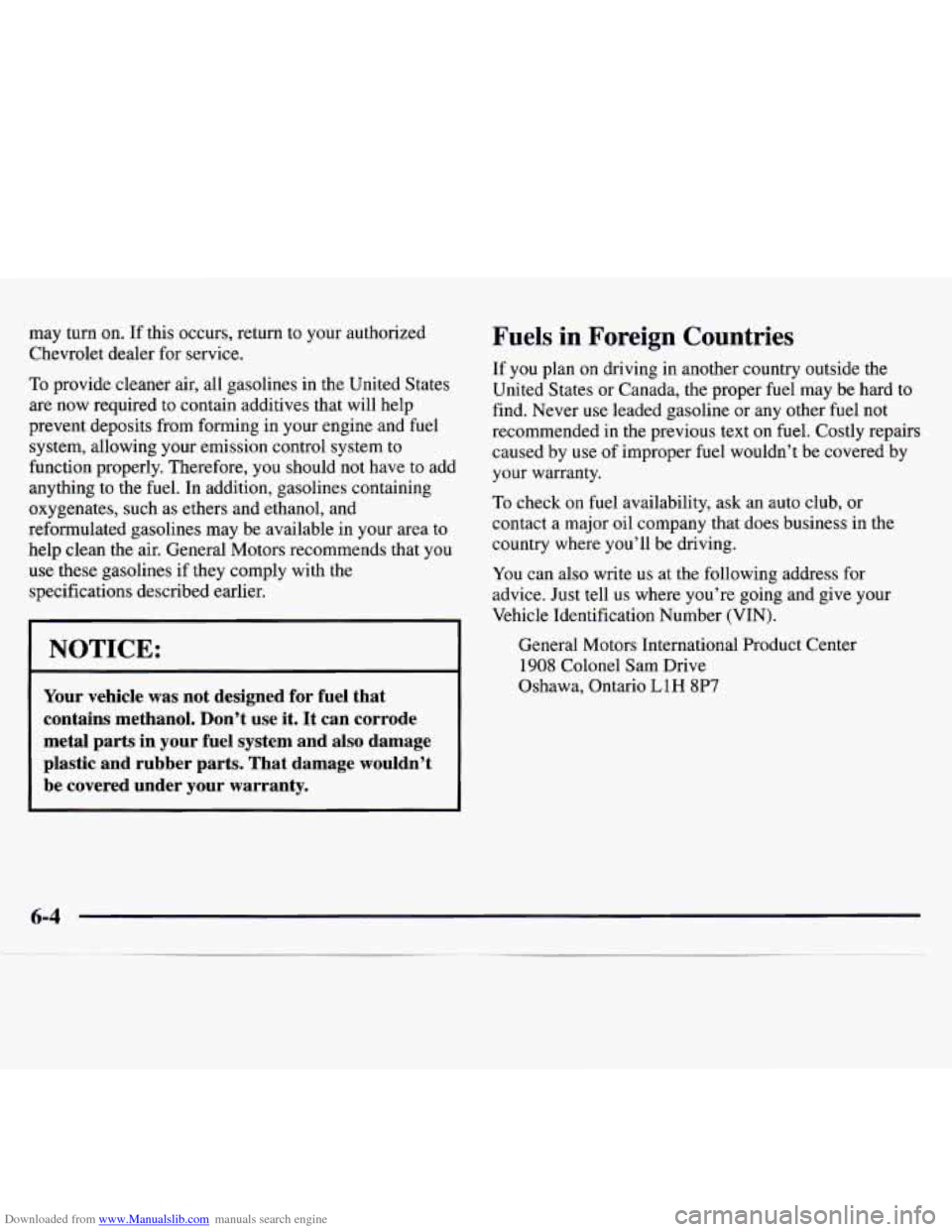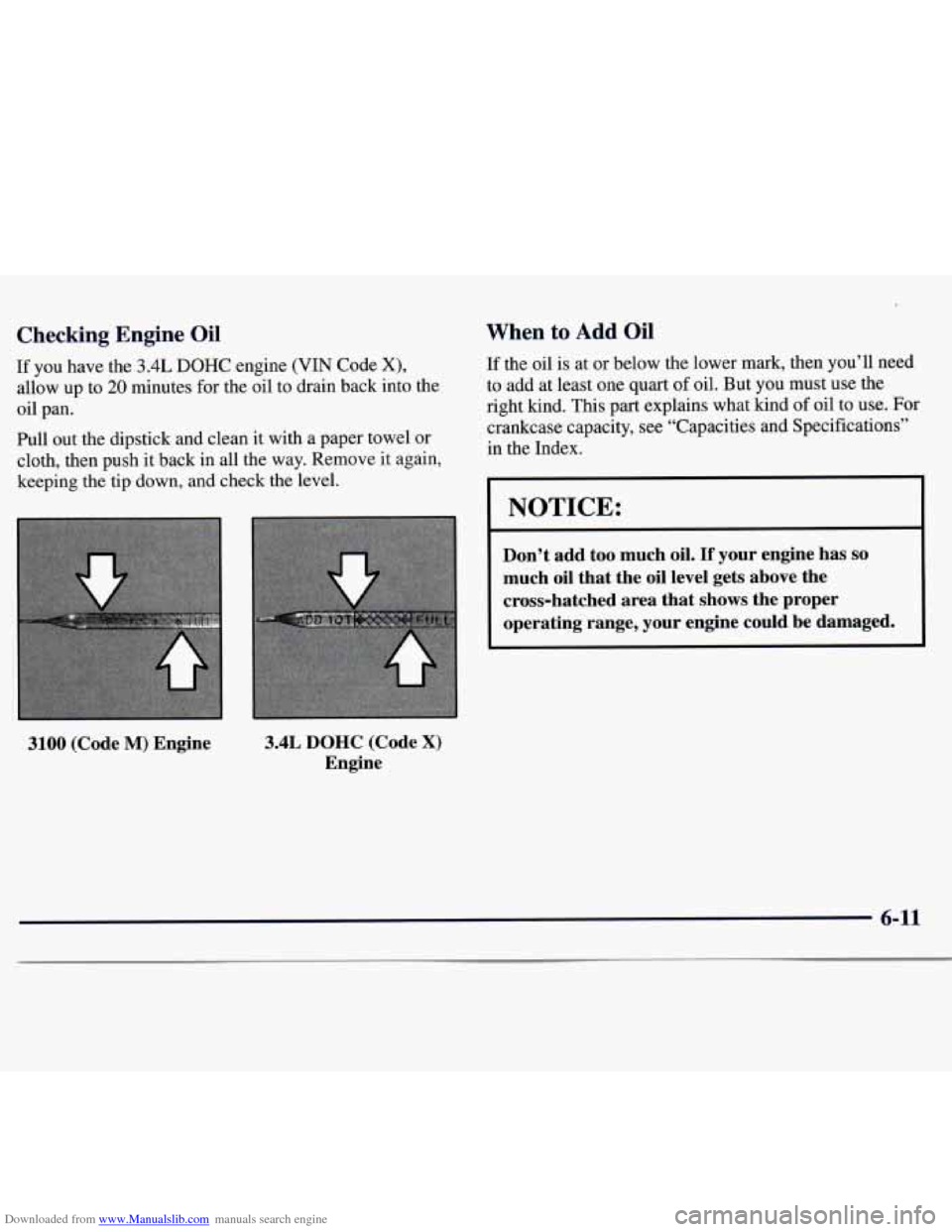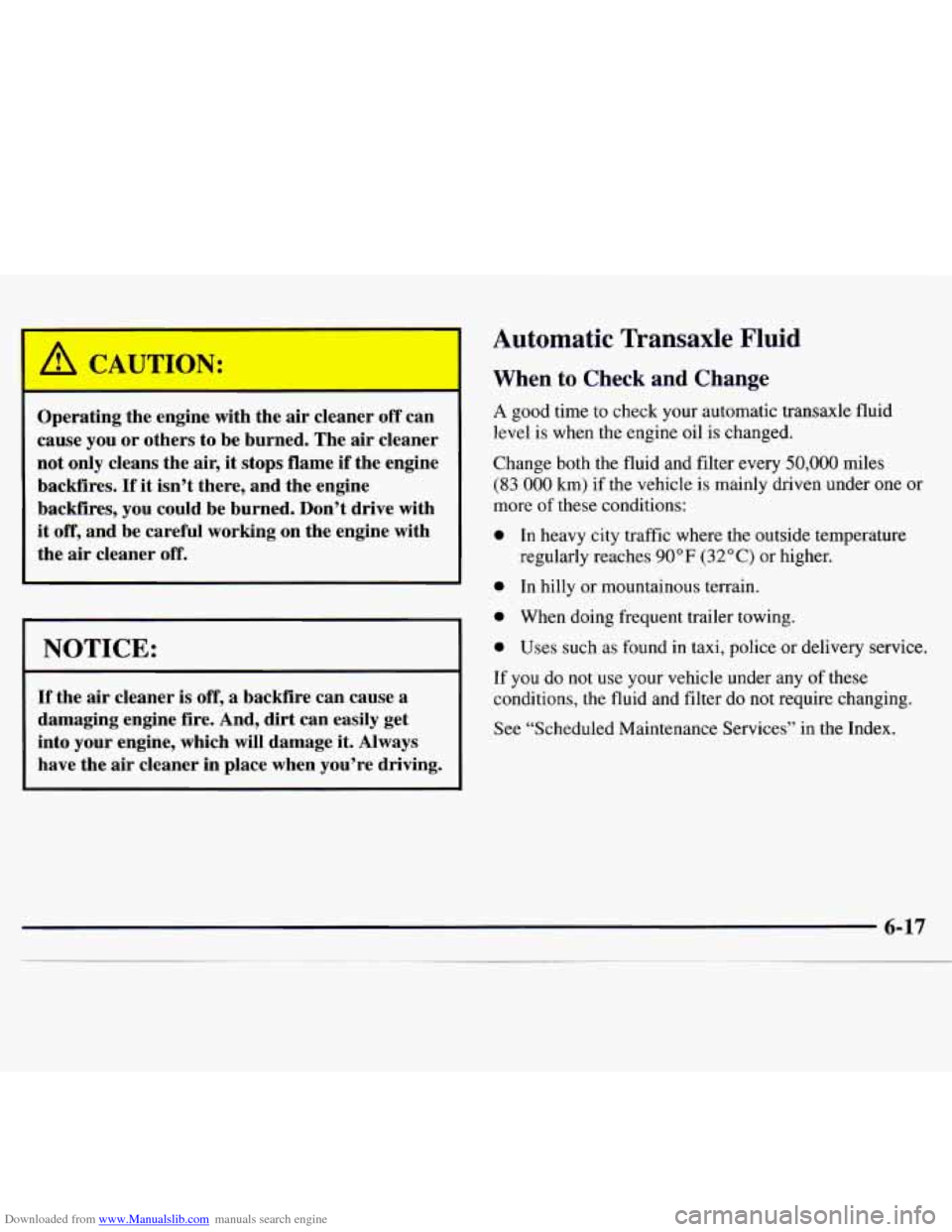1997 CHEVROLET MONTE CARLO check oil
[x] Cancel search: check oilPage 219 of 358

Downloaded from www.Manualslib.com manuals search engine may turn on. If this occurs, return to your authorized
Chevrolet dealer for service.
To provide cleaner air, all gasolines in the United States
are now required to contain additives that will help
prevent deposits from forming in your engine and fuel
system, allowing your emission control system to
function properly. Therefore, you should not have to add
anything to the fuel. In addition, gasolines containing
oxygenates, such as ethers and ethanol, and
reformulated gasolines may be available in your area to
help clean the air. General Motors recommends that you
use these gasolines if
they comply with the
specifications described earlier.
NOTICE:
Your vehicle was not designed for fuel that
contains methanol. Don’t use it. It can corrode
metal parts in your fuel system and also damage plastic and rubber parts. That damage wouldn’t be covered under your warranty.
Fuels in Foreign Countries
If you plan on driving in another country outside the
United States or Canada, the proper fuel may be hard to
find. Never use leaded gasoline or any other fuel not
recommended in the previous text
on fuel. Costly repairs
caused by use of improper fuel wouldn’t be covered by
your warranty.
To check on fuel availability, ask an auto club, or
contact a major oil company that does business in the
country where you’ll be driving.
You can also
write us at the following address for
advice. Just tell us where you’re going and give your
Vehicle Identification Number
(VIN).
General Motors International Product Center
1908 Colonel Sam Drive
Oshawa, Ontario
L1H 8P7
Page 225 of 358

Downloaded from www.Manualslib.com manuals search engine Before closing the hood, be sure all the filler caps are on
properly. Then just pull the hood down and close it firmly.
Engine Oil
LOW
OIL
If the LOW OIL light on the
instrument panel comes on,
it means
you need to check
your engine oil level right
away. For more
information, see “Low Oil
Level Light” in the Index.
You should check your
engine oil level regularly;
this is an added reminder.
It’s a good idea to check your engine oil every time
you
get fuel. In order to get an accurate reading, the oil must
be warm and the vehicle must be on level ground.
3100 (Code M) Engine 3.4L DOHC (Code X)
Engine
The engine oil dipstick handle is the yellow loop near
the front of the engine.
Turn off the engine and give the oil a few minutes to
drain back into the oil pan. If you don’t, the oil dipstick
might
not show the actual level.
Page 226 of 358

Downloaded from www.Manualslib.com manuals search engine Checking Engine Oil
If you have the 3.4L DOHC engine (VIN Code X),
allow up to 20 minutes for the oil to drain back into the
oil pan.
Pull out the dipstick and clean it with a paper towel or
cloth, then push it back in all the way. Remove it again,
keeping the tip down, and check the level.
3100 (Code M) Engine 3.4L DOHC (Code X)
Engine
When to Add Oil
If the oil is at or below the lower mark, then you’ll need
to add at least one quart of oil. But you must use the
right kind. This part explains what kind
of oil to use. For
crankcase capacity, see “Capacities and Specifications”
in the Index.
I NOTICE:
Don’t add too much oil. If your engine has so
much oil that the oil level gets above the
cross-hatched area that shows the proper
operating range, your engine could be damaged.
6-11
Page 232 of 358

Downloaded from www.Manualslib.com manuals search engine r--
Operating the engine with the air cleaner off can
cause you or others to be burned. The
air cleaner
not only cleans the air, it stops flame if the engine
backfires.
If it isn’t there, and the engine
backfires, you could be burned. Don’t drive with
it off, and be careful working on the engine with
the air cleaner
off.
I NOTICE:
If the air cleaner is off, a backfire can cause a
damaging engine fire. And, dirt can easily get
into your engine, which will damage
it. Always
have the
air cleaner in place when you’re driving.
Automatic Transaxle Fluid
When to Check and Change
A good time to check your automatic transaxle fluid
level
is when the engine oil is changed.
Change both the fluid and filter every
50,000 miles
(83 000 km) if the vehicle is mainly driven under one or
more of these conditions:
0 In heavy city traffic where the outside temperature
regularly reaches
90°F (32°C) or higher.
0 In hilly or mountainous terrain.
0 When doing frequent trailer towing.
0 Uses such as found in taxi, police or delivery service.
If you do not use your vehicle under any of these
conditions, the fluid and filter do
not require changing.
See “Scheduled Maintenance Services” in the Index.
Page 288 of 358

Downloaded from www.Manualslib.com manuals search engine I Short TripKity Maintenance Schedule I
The services shown in this schedule up to 100,000 miles
(166 000 km) should be performed after 100,000 miles
(166 000 km) at the same intervals. The services shown
at 150,000 miles
(240 000 km) should be performed at
the same interval after 150,000 miles
(240 000 km).
Footnotes
The U.S. Environmental Protection Agency or the
California Air Resources Board has determined that the
failure to perform this maintenance item will not nullify
the emission warranty or limit recall liability prior to the
completion of the vehicle’s useful life. We, however,
urge that all recommended maintenance services be
performed at the indicated intervals and the maintenance
be recorded.
+ A good time to check your brakes is during tire
rotation. See “Brake System Inspection” under “Periodic
Maintenance Inspection’’ in Part C of this schedule.
3,000 Miles (5 000 km)
0 Change engine oil and filter (or every
3 months, whichever occurs first).
An Emission Control Sewice.
I I
DATE ACTUAL MILEAGE SERVICED BY:
7-7
Page 308 of 358

Downloaded from www.Manualslib.com manuals search engine I Long Trip/Highway Maintenance Schedule I
The services shown in this schedule up to 100,000 miles
(166 000 km) should be performed after 100,000 miles
(166 000 km) at the same intervals. The services shown
at
150,000 miles (240 000 km) should be performed at
the same interval after
150,000 miles (240 000 km).
Footnotes
The U.S. Environmental Protection Agency or the
California Air Resources Board has determined that the
failure to perform this maintenance item will not nullify
the emission warranty or limit recall liability prior
to the
completion of the vehicle’s useful life. We, however,
urge that all recommended maintenance services be
performed at the indicated intervals and the maintenance
be recorded.
+ A good time to check your brakes is during tire
rotation. See “Brake System Inspection” under “Periodic
Maintenance Inspections” in Part C of this schedule.
7,500 Miles (12 500 km)
0 Change engine oil and filter (or every
12 months, whichever occurs first).
0 Rotate tires. See “Tire Inspection and
Rotation” in the Index for proper rotation
pattern and additional information.
(See footnote
+.)
An Emission Control Service.
DATE
SERVICED BY. ACTUAL MILEAGE
7-27
Page 318 of 358

Downloaded from www.Manualslib.com manuals search engine Part B: Owner Checks and Services
Listed below are owner checks and services which
should be performed at the intervals specified to help
ensure the safety, dependability and emission control
performance of your vehicle.
Be sure any necessary repairs are completed at once.
Whenever any fluids or lubricants are added to your
vehicle, make sure they
are the proper ones, as shown in
Part
D.
At Each Fuel Fill
It is important for you or a service station attendant to
pegorm these underhood checks at each
fuel fill.
Engine Oil Level Check
Check the engine oil level and add the proper oil if
necessary. See “Engine Oil” in the Index for
further details.
Engine Coolant Level Check
Check the engine coolant level and add DEX-COOL@
coolant mix if necessary. See “Engine Coolant” in the
Index for further details.
Windshield Washer Fluid Level Check
Check the windshield washer fluid level in the
windshield washer tank and add the proper fluid
if
necessary. See “Windshield Washer Fluid” in the Index
for further details.
At Least Once a Month
Tire Inflation Check
Make sure tires are inflated to the correct pressures. See
“Tires”
in the Index for further details.
Cassette Deck Service
Clean cassette deck. Cleaning should be done every
50 hours of tape play. See “Audio Systems” in the Index
for further details.
7-37
Page 347 of 358

Downloaded from www.Manualslib.com manuals search engine Brake Adjustment
.................................. 6-30
Fluid
....................................... 6-27
Master Cylinder
.............................. 6-27
Replacing System Parts
........................ 6-30
System Warning Light
.................... 2-50, 6-28
Trailer
...................................... 4-34
Transaxle Shift Interlock
....................... 2-24
Transaxle Shift Interlock Check
.................. 7-39
Brakes, Anti-Lock
............................... 4-7
Braking
........................................ 4-6
Braking in Emergencies
........................... 4-9
Break-In, New Vehicle
.......................... 2- 12
Brightness Control
.............................. 2-34
BTSI
......................................... 2-24
Bulb Replacement
.............................. 6-3 1
Canadian Roadside Assistance .................... 8-7
Capacities and Specifications
...................... 6-63
Carbon Monoxide
................ 2-8,2-25,4-27, 4-33
Cassette Deck Service
........................... 7-37
Cassette Tape Player
............................. 3-7
Cassette Tape Player Care
........................ 3- 19
Center High-Mounted Stoplamp Bulb Replacement
.... 6-34
Center Passenger Position
........................ 1-26
CertificationLabel
.............................. 4-29
Chains, Safety
................................. 4-34
Chains. Tire
................................... 6-45
Parking
..................................... 2-20
PedalTravel
................................. 6-30
Wear
....................................... 6-29
BTSICheck
................................... 7-39 Change Oil Soon Light
.......................... 2-58
Changing a Flat Tire
............................. 5-24
Charging System Light
.......................... 2-49
Checking Your Restraint Systems
.................. 1-45
Chemical Paint Spotting
.......................... 6-53
Child Restraints
................................ 1-34
Securing
in a Rear Outside Seat Position ........... 1-36
Securing
in the Center Rear Seat Position .......... 1-38
Securing in the Passenger Seat Position
........... 1-39
Securing in the Right Front Seat Position
.......... 1-39
TopStrap
....,.....,......,................. l-35
WheretoPut ................................ 1-34
Cigarette Lighter
............................... 2-39
Circuit Breakers and Fuses
....................... 6-56
Cleaner, Air
................................... 6-16
Cleaning
...................................... 6-46
Aluminum Wheels
............................ 6-52
Exterior Lampshenses
........................ 6-51
Glass Surfaces ............................... 6-50
Inside of Your Chevrolet
....................... 6-46
Outside
of Your Chevrolet ...................... 6-51
Special Problems ............................. 6-48
Vinyl
....................................... 6-49
Windshield and Wiper Blades
................... 6-50
Fabric
...................................... 6-46
FabricProtection
............................. 6-47
Instrumentpanel
............................. 6-49
Leather
..................................... 6-49
SafetyBelts
................................. 6-50
Stains
...................................... 6-46
Tires
....................................... 6-52
Wheels
..................................... 6-51
9-2